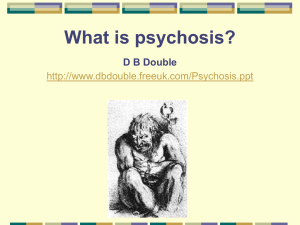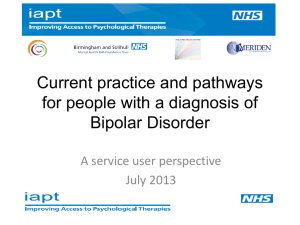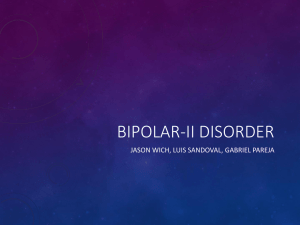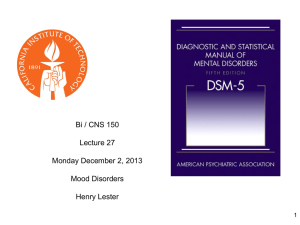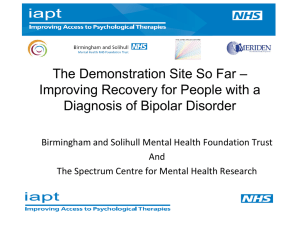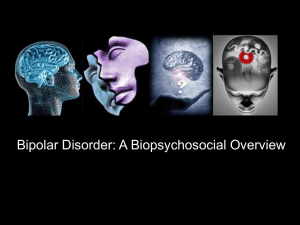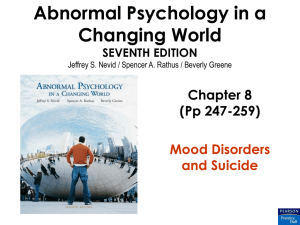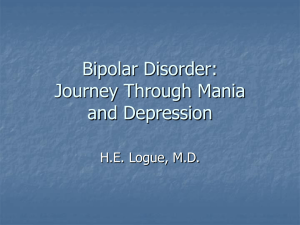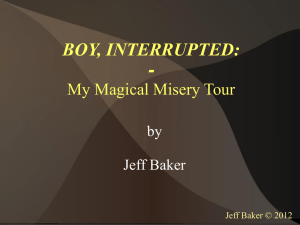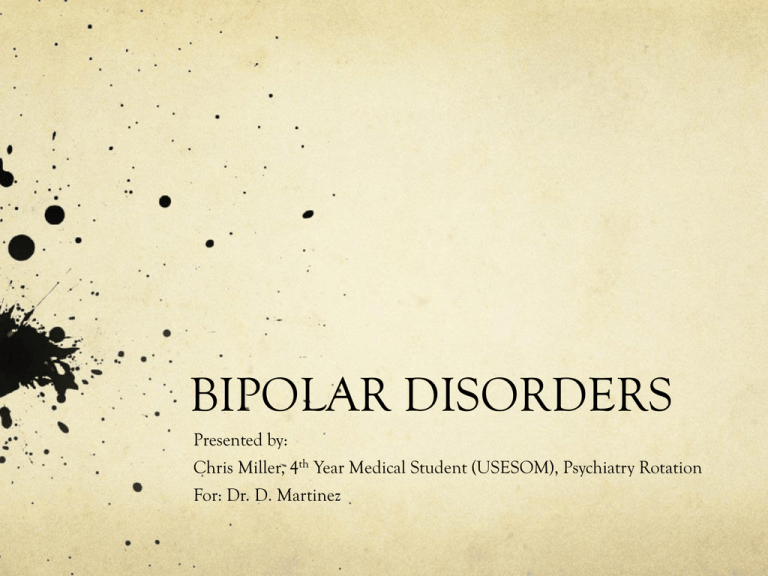
BIPOLAR DISORDERS
Presented by:
Chris Miller, 4th Year Medical Student (USESOM), Psychiatry Rotation
For: Dr. D. Martinez
TOPICS COVERED
Bipolar I Disorder
Bipolar II Disorder
Cyclothymic Disorder
The epidemiology, etiology, clinical manifestations, and
management of each disorder will also be covered.
BIPOLAR I DISORDER
Most serious of all bipolar
disorders
Diagnosed after at least one
episode of mania.
Patients also may experience
major depressive episodes in
the course of their lives.
http://www.bipolardisorder-symptoms.net/wpcontent/uploads/2010/12/bipolar-disorder-symptoms-3.jpg
DIAGNOSTIC CRITERIA FOR
MANIC EPISODES
THREE TO FOUR OF THE FOLLOWING CRITERIA ARE REQUIRED
DURING THE ELEVATED MOOD PERIOD
Highly inflated or grandiose self-esteem
Decreased need for sleep, or rested after only a few hours of sleep
Pressured speech
Racing thoughts and flight of ideas
Easy distractibility, failure to keep attention
Increased goal-directed activity
High excess involvement in pleasurable activities (sex, travel, spending money)
General criteria for a manic episode require a period of elevated, expansive, or
irritable mood that lasts 1 week or requires hospitalization. A general medical
condition and substance abuse must be ruled out before these symptoms are
considered mania.
DIFFERENTIAL DIAGNOSIS
OF MANIA
May be induced by:
Antidepressant medications
Psychostimulants
Electroconvulsive therapy
Phototherapy
If the above occurs, the patient is diagnosed with
substance-induced mood disorder
EPIDEMIOLOGY OF BIPOLAR
I DISORDER
The lifetime prevalence is 0.4% to 1.6%
The ratio of males to females affected is equal
There are no racial variations in incidence
ETIOLOGY OF BIPOLAR I
DISORDER
Genetic studies indicate that
bipolar I disorder is
associated with increased
bipolar I, bipolar II, and
major depressive episodes in
first-degree relatives.
X-linkage has been shown in
some studies but is still
controversial.
Mania can be precipitated
by:
Psychosocial stressors
Sleep/wake cycle changes
http://img.thebody.com/legacyAssets/62/93/bipolar.gif
CLINICAL MANIFESTATIONS
OF BIPOLAR I DISORDER
Defined by the occurrence of a manic episode
A single manic episode is sufficient enough to meet
diagnostic criteria but most patients have recurrent manic
episodes mixed with depressive episodes
The 1st episode of mania usually occurs in the early 20s
Lifetime suicide rates range from 10% to 15%
CLINICAL MANIFESTATIONS OF
BIPOLAR I DISORDER (CONT.)
Children can also present with bipolar disorder that resembles the
adult type but differs according to their age and developmental
level.
Very young children may present with uncontrollable giggling.
School-age children may try to teach their grammar class in the
presence of their teacher.
Adolescents may present with severe anger outbursts and
agitation.
Most children with bipolar disorder have more than one relative
with the same condition.
MANAGEMENT OF BIPOLAR I
DISORDER
The following medications can be used:
Antipsychotics
Benzodiazepines
Mood stabilizers (valproic acid, lithium)
Combination therapy is more effective than monotherapy
Some atypical antipsychotics such as clozapine, quetiapine,
olanzapine, and aripiprazole can be used for maintenance
Electroconvulsive therapy can also be used for refractory
cases and patients intolerant to medications.
BIPOLAR II DISORDER
Bipolar II disorder is similar
to bipolar I disorder except
that mania is absent in
bipolar II disorder.
Hypomania is the essential
diagnostic finding.
Hypomania is a milder form
of elevated mood than
mania.
http://stahlonline.cambridge.org/content/ep/images/85702
c11_fig8.jpg
BIPOLAR II DISORDER
EPIDEMIOLOGY
ETIOLOGY
The lifetime prevalence of bipolar II
disorder is about 0.5%
Same factors as bipolar I disorder
More common in women
http://knowingbipolardisorder.com/wpcontent/uploads/2009/01/bipolar-2-288x300.jpg
CLINICAL MANIFESTATIONS
OF BIPOLAR II DISORDER
Characterized by the occurrence of hypomania and episodes
of major depression in an individual who has never met
criteria for mania or a mixed state.
Hypomania is determined by the same symptom complex as
mania, but the symptoms are less severe, cause less
impairment, and usually do not require hospitalization.
Bipolar II is cyclic
Suicide occurs in 10% to 15% of patients (same as bipolar I)
MANAGEMENT OF BIPOLAR
II DISORDER
The treatment is the same
as for bipolar I disorder
Hypomanic episodes do
not require as aggressive a
treatment as mania.
http://www.themedicalguru.com/wpcontent/uploads/2010/07/medicine_pills.jpg
CYCLOTHYMIC DISORDER
Cyclothymic disorder is a
recurrent, chronic, mild
form of bipolar disorder
in which mood typically
oscillates between
hypomania and
dysthymia.
If a manic episode or
depressive episode is
experienced, cyclothymic
disorder is not diagnosed.
http://www.allaboutdepression.com/cyclothymia/images/graphic
2.gif
CYCLOTHYMIC DISORDER
EPIDEMIOLOGY
ETIOLOGY
The lifetime prevalence of cyclothymic Genetic and familial studies reveal an
disorder is 0.4% to 1%.
association with other mood disorders
The rate appears equal in men and
women, although women are usually
more likely to seek treatment
CLINICAL MANIFESTATIONS
OF CYCLOTHYMIC DISORDER
Cyclothymic disorder is a milder form of bipolar
disorder consisting of recurrent mood disturbances
between hypomania and dysthymic mood.
A single episode of hypomania is sufficient enough to
diagnose cyclothymic disorder, although most
individuals also have dysthymic periods.
Cyclothymic disorder is never diagnosed when there is
a history of mania, major depressive episode, or mixed
episode.
MANAGEMENT OF
CYCLOTHYMIC DISORDER
Cyclothymic disorder can
be treated with:
Psychotherapy
Mood stabilizers
Antidepressants
Patients with cyclothymic
disorder may never seek
medical attention for their
mood symptoms
http://www.cyclothymiasymptoms.com/help/images/7.jpeg
CONCLUSION
Bipolar I disorder
Diagnosed by at least one
manic episode and
usually experiences
depressive episodes
Bipolar II disorder
Hypomania with
depressive episodes
Cyclothymic disorder
Cyclic disorder oscillating
between hypomania and
dysthymia
http://www.free-pressrelease.com/uploads/news/2010/07/18/1279479453_img1.jpg
REFERENCES
Kaplan USMLE STEP 2 CK Lecture Notes 2010, psychiatry
section
http://www.ncbi.nlm.nih.gov/pubmedhealth/PMH000251
7/
http://www.nimh.nih.gov/health/publications/bipolardisorder/complete-index.shtml
BluePrints Psychiatry, Lippincott Williams and Wilkins,
2009, mood disorders, pg 8
http://en.wikipedia.org/wiki/Bipolar_disorder

